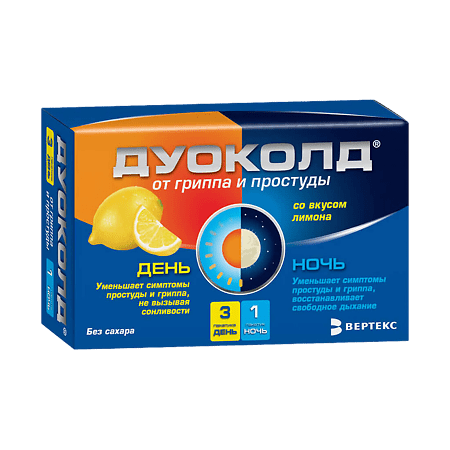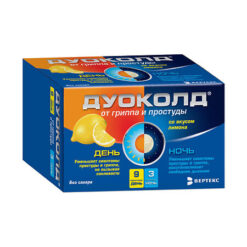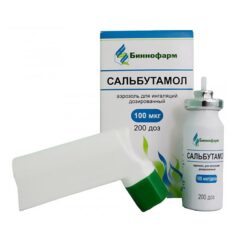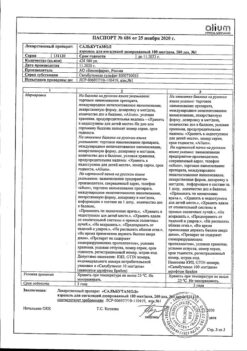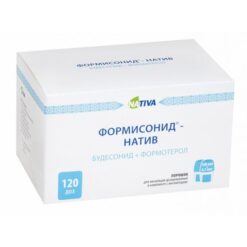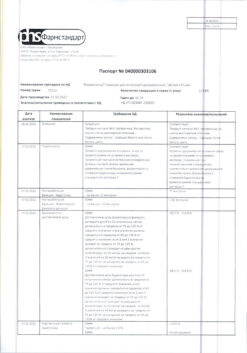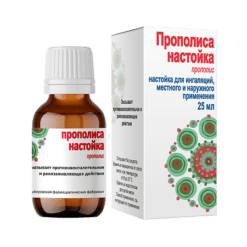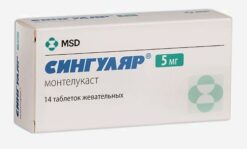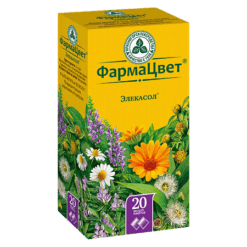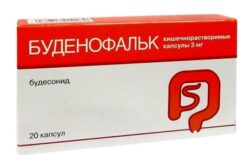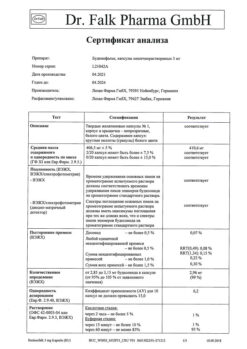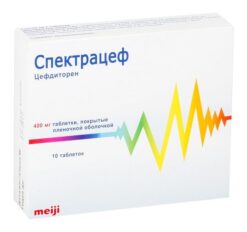No products in the cart.
Duocold set, lemon day 3 pcs./night
€6.24 €5.20
Description
Pharmacotherapeutic group
Acute respiratory infections and “colds” symptoms remedy (vitamin+calcium-phosphorus metabolism regulator+non-narcotic analgesic+angioprotector+alpha-adrenomimetic+H1-histamine receptor blocker)
Attoxic and anti-inflammatory/p>
ATX code
N02BE51
p> Pharmacological properties
Pharmacodynamics
A combined preparation, the action of which is due to its constituent components, has antipyretic, anti-inflammatory, analgesic, anti-allergic, angioprotective and vasoconstrictor action. Eliminates symptoms of “colds”. Narrowes nasal vessels, eliminates nasal mucosal edema.
Ascorbic acid (vitamin C) – make up for the increased need for vitamin C in colds and flu, especially in the initial stages of the disease. It increases resistance to infectious diseases, participates in the regulation of redox processes, promotes normal capillary permeability, blood coagulation and tissue regeneration.
Calcium gluconate replenishes the lack of calcium ions required for the transmission of nerve impulses, the contraction of skeletal and smooth muscles, myocardial function, bone formation, blood clotting. It has anti-allergic effect, prevents the development of increased permeability and fragility of blood vessels that cause hemorrhagic processes in influenza and acute respiratory viral infections.
Paracetamol – non-narcotic analgesic, blocks structural enzyme cyclooxygenase-1 (COX-1) and inducible enzyme (COX-2) mainly in the central nervous system, affecting the centers of pain and thermoregulation. It has analgesic and antipyretic effects. It reduces headache, muscle pain and fever. It does not affect platelet function and hemostasis.
Rutozide is an angioprotector. Reduces capillary permeability, swelling and inflammation, strengthens the vascular wall. It prevents the development of increased vascular permeability and fragility that causes hemorrhagic processes. Rutoside participates in redox processes, has antioxidant properties, prevents oxidation and promotes ascorbic acid deposition in tissues.
Phenylephrine is a symptomatic agent, stimulates postsynaptic alpha1-adrenoreceptors, has a moderate vasoconstrictor effect, reduces swelling and hyperemia of the nasal mucosa, restores free breathing, reduces pressure in the paranasal cavities and middle ear.
Pheniramine – is an anti-allergic agent – a blocker of H1-histamine receptors. It reduces nasal congestion, sneezing, lacrimation, itching and red eyes. It has a moderate sedative effect.
Pharmacokinetics
Ascorbic acid
Ascorbic acid.Absorption
Askorbic acid is completely absorbed from the gastrointestinal tract after ingestion.
Distribution
Widely distributed in body tissues. Time of reaching maximum plasma concentration (TSmax) after oral administration is 4 hours. Binding with blood plasma proteins is 25%. The concentration of ascorbic acid in leukocytes and platelets is higher than in erythrocytes and plasma. It penetrates through the placenta and enters the breast milk.
Metabolism and excretion
Metabolized mainly in the liver to deoxyascorbic acid and then to oxalic acid and ascorbate-2-sulfate. It is excreted by the kidneys unchanged and as metabolites.
Calcium gluconate
Approximately 1/5-1/3 of orally administered calcium gluconate is absorbed in the small intestine, this process depends on the presence of vitamin D, pH, dietary characteristics and the presence of factors that can bind calcium ions. Absorption of calcium ions increases with calcium deficiency and the use of a diet with reduced calcium ions. About 20% is excreted by the kidneys, the rest (80%) by the intestine.
Paracetamol
absorption
Paracetamol is quickly and almost completely absorbed from the gastrointestinal tract after oral administration. Maximum plasma concentrations are reached 10-60 minutes after oral administration.
Distribution
Paracetamol is distributed in most body tissues, penetrates the placenta and is present in breast milk. In therapeutic concentrations, the binding to plasma proteins is insignificant, increasing with increasing concentrations.
Metabolism
It is subjected to primary metabolism in liver, eliminated mainly by kidneys as glucuronide and sulfate compounds. Elimination half-life is 1-3 hours.
Rutozide
In oral administration 10-15% of the dose is absorbed, maximum plasma concentration is reached after 1-9 hours, half-life is 10-25 hours; excreted mainly with bile.
Phenylephrine
absorption and metabolism
It is absorbed from the gastrointestinal tract and undergoes primary metabolism in the intestine and liver. Maximum plasma concentrations are reached between 45 minutes and 2 hours.
Elimation
Extracted almost completely by the kidneys as sulfate compounds. The elimination half-life is 2-3 hours.
Pheniramine
Distribution
After oral administration the maximum plasma concentration is reached after 1-2.5 hours. The elimination half-life in the final phase is 16-19 hours.
Elimation
Extracted by the kidneys (70-83%) as unchanged substance or metabolites.
Indications
Indications
Symptomatic treatment of infectious and inflammatory diseases: ARVI (acute respiratory viral infection), including influenza and “colds”, accompanied by fever, chills, headache, joint and muscle pain, runny nose, nasal congestion, sneezing and pain in the throat and sinuses.
Pharmacological effect
Pharmacological effect
Pharmacotherapeutic group
Acute respiratory infections and “cold” symptoms remedy (vitamin + calcium-phosphorus metabolism regulator + analgesic non-narcotic drug + angioprotector + alpha-adrenergic agonist + H1-histamine receptor blocker)
ATX code
N02BE51
Pharmacological properties
Pharmacodynamics
The combined drug, the effect of which is determined by the components included in its composition, has antipyretic, anti-inflammatory, analgesic, antiallergic, angioprotective and vasoconstrictor effects. Eliminates cold symptoms. Constricts nasal vessels, eliminates swelling of the nasal mucosa.
Ascorbic acid (vitamin C) – replenishes the increased need for vitamin C during colds and flu, especially in the initial stages of the disease. Increases the body’s resistance to infectious diseases, participates in the regulation of redox processes, promotes normal capillary permeability, blood clotting, and tissue regeneration.
Calcium gluconate – replenishes the deficiency of calcium ions necessary for the transmission of nerve impulses, contraction of skeletal and smooth muscles, myocardial activity, bone tissue formation, and blood clotting. It has an antiallergic effect, prevents the development of increased permeability and fragility of blood vessels, which cause hemorrhagic processes in influenza and acute respiratory viral infections (ARVI).
Paracetamol is a non-narcotic analgesic that blocks the structural enzyme cyclooxygenase-1 (COX-1) and the inducible enzyme (COX-2) mainly in the central nervous system, affecting the centers of pain and thermoregulation. Has an analgesic and antipyretic effect. Reduces headaches, muscle pain, and fever. Does not affect platelet function and hemostasis.
Rutoside is an angioprotector. Reduces capillary permeability, swelling and inflammation, strengthens the vascular wall. Prevents the development of increased permeability and fragility of blood vessels, causing hemorrhagic processes. Rutoside is involved in redox processes, has antioxidant properties, prevents oxidation and promotes the deposition of ascorbic acid in tissues.
Phenylephrine is a symptomatic remedy, stimulates postsynaptic alpha1-adrenergic receptors, has a moderate vasoconstrictor effect, reduces swelling and hyperemia of the nasal mucosa, restores free breathing, lowers pressure in the paranasal cavities and middle ear.
Pheniramine is an antiallergic drug – a blocker of H1-histamine receptors. Reduces nasal congestion, sneezing, watery eyes, itching and redness of the eyes. Has a moderate sedative effect.
Pharmacokinetics
Ascorbic acid
Suction
After oral administration, ascorbic acid is completely absorbed from the gastrointestinal tract.
Distribution
Widely distributed in body tissues. The time to reach maximum concentration in blood plasma (TCmax) after oral administration is 4 hours. Communication with blood plasma proteins – 25%. The concentration of ascorbic acid in leukocytes and platelets is higher than in erythrocytes and plasma. Penetrates the placenta and enters breast milk.
Metabolism and excretion
Metabolized primarily in the liver into deoxyascorbic acid and further into oxalic acid and ascorbate-2-sulfate. It is excreted by the kidneys unchanged and in the form of metabolites.
Calcium gluconate
Approximately 1/5-1/3 of orally administered calcium gluconate is absorbed in the small intestine, this process depends on the presence of vitamin D, pH, diet and the presence of factors that can bind calcium ions. The absorption of calcium ions increases with calcium deficiency and the use of a diet with a reduced content of calcium ions. About 20% is excreted by the kidneys, the rest (80%) by the intestines.
Paracetamol
Suction
After oral administration, paracetamol is quickly and almost completely absorbed from the gastrointestinal tract. The maximum concentration in blood plasma is achieved 10-60 minutes after oral administration.
Distribution
Paracetamol is distributed in most body tissues, crosses the placenta and is present in breast milk. At therapeutic concentrations, binding to plasma proteins is insignificant and increases with increasing concentration.
Metabolism
It undergoes primary metabolism in the liver and is excreted mainly by the kidneys in the form of glucuronide and sulfate compounds. The half-life is 1-3 hours.
Rutoside
When taken orally, 10-15% of the dose is absorbed, the maximum concentration in the blood plasma is reached after 1-9 hours, the half-life is 10-25 hours; excreted primarily in bile.
Phenylephrine
Absorption and Metabolism
Absorbed from the gastrointestinal tract and undergoes primary metabolism in the intestines and liver. The maximum concentration in blood plasma is achieved in the range from 45 minutes to 2 hours.
Removal
It is excreted almost completely by the kidneys in the form of sulfate compounds. The half-life is 2-3 hours.
Pheniramine
Distribution
After oral administration, the maximum concentration in blood plasma is achieved within 1-2.5 hours. The half-life in the terminal phase is 16-19 hours.
Removal
Excreted by the kidneys (70-83%) in the form of unchanged substance or metabolites.
Special instructions
Special instructions
To avoid toxic liver damage, the drug should not be combined with the use of alcoholic beverages.
Patients should consult a doctor if:
bronchial asthma, emphysema or chronic bronchitis is observed;
symptoms do not go away within 5 days or are accompanied by severe fever lasting 3 days, rash, or persistent headache.
These may be signs of more serious problems.
The drug contains 200 mg sodium citrate per sachet. This should be taken into account by patients on a sodium-low diet.
Do not use the drug from damaged sachets.
The drug should not be taken simultaneously with other drugs containing paracetamol.
Impact on the ability to drive vehicles and machinery
Pheniramine, which is part of the contents of the “Night” sachet, can cause drowsiness, so during treatment it is not recommended to drive a car or engage in other activities that require concentration and high speed of psychomotor reactions.
Active ingredient
Active ingredient
Ascorbic acid, Calcium gluconate, Paracetamol, Rutoside, Phenylephrine
Composition
Composition
Powder for preparing a solution for oral administration “Day”: One sachet “Day” contains:
active ingredients: paracetamol – 325 mg, ascorbic acid – 200 mg, calcium gluconate monohydrate – 200 mg, rutoside – 20 mg, phenylephrine hydrochloride – 10 mg; excipients: mannitol, sodium citrate, lemon or cranberry flavor, citric acid monohydrate, aspartame, povidone K-30.
Powder for preparing a solution for oral administration “Night”: One sachet “Night” contains:
active ingredients: paracetamol – 500 mg, ascorbic acid – 200 mg, calcium gluconate monohydrate – 200 mg, rutoside – 20 mg, pheniramine maleate – 20 mg, phenylephrine hydrochloride – 10 mg;
excipients: mannitol, sodium citrate, lemon or cranberry flavor, citric acid monohydrate, aspartame, povidone K-30.
Pregnancy
Pregnancy
The drug is not recommended for use during pregnancy and breastfeeding due to the lack of data on the safe use of the drug in these individuals.
Contraindications
Contraindications
hypersensitivity to paracetamol, rutoside, phenylephrine, pheniramine, ascorbic acid and other components included in the drug;
simultaneous use of paracetamol-containing drugs;
simultaneous use of tricyclic antidepressants, beta-blockers, and other sympathomimetic drugs;
simultaneous or within the previous 2 weeks taking monoamine oxidase inhibitors (MAO);
severe cardiovascular diseases;
arterial hypertension;
angle-closure glaucoma;
tendency to thrombosis;
pheochromocytoma, hyperthyroidism;
portal hypertension;
alcoholism;
diabetes mellitus;
pregnancy, breastfeeding period;
phenylketonuria;
children under 12 years of age;
hypercalcemia (calcium concentration should not exceed 12 mg%);
severe hypercalciuria;
nephrourolithiasis (calcium);
simultaneous use of cardiac glycosides (risk of arrhythmias).
With caution
severe atherosclerosis of the coronary arteries;
cardiovascular diseases;
acute hepatitis;
hemolytic anemia;
severe liver or kidney disease;
prostatic hyperplasia, difficulty urinating due to prostatic hypertrophy;
blood diseases;
deficiency of glucose-6-phosphate dehydrogenase;
congenital hyperbilirubinemia (Gilbert, Dubin-Johnson and Rotor syndromes);
bronchial asthma;
chronic malnutrition (calorie deficit) and dehydration;
pyloroduodenal obstruction;
stenosing ulcer of the stomach and/or duodenum;
epilepsy;
simultaneous use of drugs that can adversely affect the liver (barbiturates, phenytoin, phenobarbital, carbamazepine, rifampicin, isoniazid, zidovudine and other inducers of microsomal liver enzymes).
Side Effects
Side Effects
The incidence of side effects is mainly dose-dependent. Classification of the incidence of side effects (WHO):
very often ≥1/10;
often from ≥ 1/100 to < 1/10; infrequently from ≥ 1/1000 to < 1/100; rarely from ≥ 1/10000 to < 1/1000;
very rare <1/10000, including individual reports;
frequency unknown – based on available data, it is not possible to determine the frequency of occurrence.
In therapeutic doses, the drug is usually well tolerated, but the following side effects may occur.
Blood and lymphatic system disorders:
very rarely – thrombocytopenia, agranulocytosis, leukopenia, pancytopenia.
Immune system disorders:
rarely – hypersensitivity reactions (rash, shortness of breath, anaphylactic shock), angioedema;
frequency unknown – anaphylactic reaction, Stevens-Johnson syndrome, toxic epidermal necrolysis.
Mental disorders:
rarely – increased excitability, sleep disturbance (when taking the contents of the sachets
“Day”).
Nervous system disorders:
often – drowsiness (when taking the contents of “Night” sachets); rarely – dizziness, headache.
Visual disorders:
rarely – mydriasis, accommodation paresis, increased intraocular pressure.
Cardiac disorders:
rarely – tachycardia, palpitations.
Vascular disorders:
rarely – increased blood pressure.
Gastrointestinal disorders:
often – nausea, vomiting;
rarely – dryness of the oral mucosa, constipation, abdominal pain, diarrhea.
Liver and biliary tract disorders:
rarely – increased activity of liver enzymes.
Skin and subcutaneous tissue disorders:
rarely – rash, itching, erythema, urticaria.
Renal and urinary tract disorders:
rarely – difficulty urinating.
General disorders and reactions at the injection site:
rarely – malaise.
If any of the side effects indicated in the instructions get worse, or you notice any other side effects not listed in the instructions, tell your doctor.
Interaction
Interaction
Effect of ascorbic acid
When used simultaneously with barbiturates, primidone, tetracycline, the excretion of ascorbic acid in the urine increases.
With simultaneous use of oral contraceptives, the concentration of ascorbic acid in the blood plasma decreases.
It is possible to increase the concentration of ethinyl estradiol in the blood plasma when used simultaneously as part of oral contraceptives.
When used simultaneously with iron supplements, ascorbic acid, due to its restorative properties, converts ferric iron into divalent iron, which helps improve its absorption.
Ascorbic acid in high doses can reduce urine pH, which, when used simultaneously, reduces the tubular reabsorption of amphetamine and tricyclic antidepressants.
When used simultaneously, acetylsalicylic acid reduces the absorption of ascorbic acid by about a third.
When used simultaneously with warfarin, the effects of warfarin may be reduced.
Effect of calcium gluconate
When administered orally, calcium gluconate slows down the absorption of tetracyclines, digoxin, and oral iron supplements (the interval between doses should be at least 2 hours).
With simultaneous use under the influence of cholestyramine, the absorption of calcium from the gastrointestinal tract is reduced.
Calcium gluconate, when used simultaneously, reduces the hypotensive effect of calcium channel blockers (iv administration of calcium gluconate before and after verapamil reduces its hypotensive effect).
During treatment with cardiac glycosides, parenteral use of calcium gluconate is not recommended (possible increased cardiotoxic effects). Concomitant use with quinidine may slow intraventricular conduction and increase the toxicity of quinidine.
When combined with thiazide diuretics, calcium gluconate can increase hypercalcemia, reduce the effect of calcitonin in hypercalcemia, and reduce the bioavailability of phenytoin.
Effect of paracetamol
Enhances the effects of MAO inhibitors, sedatives, ethanol.
The risk of hepatotoxic action of paracetamol increases with simultaneous use of barbiturates, phenytoin, phenobarbital, carbamazepine, rifampicin, isoniazid, zidovudine and other inducers of microsomal liver enzymes.
The anticoagulant properties of warfarin and other coumarins may be enhanced by long-term regular use of paracetamol, increasing the risk of bleeding. A single dose of paracetamol does not have this effect. Metoclopramide increases the rate of absorption of paracetamol and increases the concentration of paracetamol in the blood plasma to a maximum. Likewise, domperidone may increase the rate of absorption of paracetamol.
When chloramphenicol and paracetamol are used together, the half-life of chloramphenicol may increase.
Paracetamol may reduce the bioavailability of lamotrigine with a possible decrease in its effect due to induction of its hepatic metabolism. The absorption of paracetamol may be reduced when taken concomitantly with cholestyramine, but this can be avoided if cholestyramine is taken one hour after paracetamol.
Regular use of paracetamol concomitantly with zidovudine may cause neutropenia and increase the risk of liver damage. Probenecid affects the metabolism of paracetamol. In patients taking probenecid concomitantly, the dose of paracetamol should be reduced.
The hepatotoxicity of paracetamol may be increased by chronic or excessive alcohol consumption. Paracetamol may interfere with the results of the uric acid test using the phosphotungstate precipitating reagent.
Effect of rutoside
Ascorbic acid enhances the effects of rutoside.
Effect of phenylephrine
The drug is contraindicated in patients who are taking or have taken MAO inhibitors within the last two weeks. MAO inhibitors, tricyclic antidepressants (for example, amitriptyline), ergot alkaloids, sympathomimetics enhance the pressor effect, and the latter enhance the arrhythmogenicity of phenylephrine.
Phenylephrine may reduce the effectiveness of beta blockers and other antihypertensive drugs (eg, debrisoquine, guanethidine, reserpine, methyldopa). The risk of arterial hypertension increases.
Concomitant use of phenylephrine with digoxin and other cardiac glycosides may increase the risk of arrhythmia or myocardial infarction.
Thyroid hormones increase (mutually) the risk of coronary insufficiency (especially with coronary atherosclerosis).
Alpha blockers (phentolamine), phenothiazines, furosemide and other diuretics prevent vasoconstriction.
Effect of pheniramine
The effect of other substances on the central nervous system may be enhanced (for example, MAO inhibitors, tricyclic antidepressants, alcohol, antiparkinsonian drugs, barbiturates, tranquilizers and narcotic drugs). Pheniramine may inhibit the effect of anticoagulants.
Overdose
Overdose
The most dangerous symptoms of a drug overdose can be caused by paracetamol.
Paracetamol
Symptoms (appear after a single dose of 7.5-10 g of paracetamol): in severe cases of overdose, paracetamol has a hepatotoxic effect, including can cause liver necrosis. Also, an overdose can cause nephropathy with irreversible liver failure.
The severity of an overdose depends on the dose, so patients should be warned against simultaneous use of paracetamol-containing drugs. The risk of poisoning is especially high in elderly patients, children, patients with liver disease, in cases of chronic alcoholism, in patients with chronic malnutrition (calorie deficiency) and in patients taking inducers of microsomal oxidation in the liver.
An overdose of paracetamol can lead to liver failure, encephalopathy, coma and death.
Symptoms of paracetamol overdose in the first 24 hours: pale skin, nausea, vomiting, anorexia, convulsions. Abdominal pain may be the first sign of liver damage and usually does not appear in the first 24-48 hours and can sometimes appear later, after 4-6 days, on average 72-96 hours after taking the drug. Impaired glucose metabolism and metabolic acidosis may also occur. Even in the absence of liver damage, acute renal failure and acute tubular necrosis can develop. Cases of cardiac arrhythmia and pancreatitis have been reported with paracetamol overdose.
Treatment: intravenous or oral acetylcysteine as an antidote, gastric lavage, and oral methionine may have a beneficial effect for at least the first 48 hours after an overdose.
It is recommended to take activated carbon and monitor breathing and circulation. If seizures develop, diazepam may be prescribed.
Ascorbic acid
Symptoms: when taking more than 1 g per day, heartburn, diarrhea, difficulty urinating or red urine, hemolysis (in patients with glucose-6-phosphate dehydrogenase deficiency) are possible.
Calcium gluconate
Symptoms: development of hypercalcemia: nausea, vomiting, severe weakness, thirst, drowsiness, disorientation, confusion, renal failure. The maximum daily dose for adults and children over 12 years of age is 9 g.
Treatment: calcitonin intravenously 5-10 IU/kg per day (diluted in 500 ml of isotonic sodium chloride solution, administered over 6 hours).
Pheniramine and phenylephrine (symptoms of overdose are combined due to the risk of mutual potentiation of the parasympatholytic effect of pheniramine and the sympathomimetic effect of phenylephrine in case of drug overdose).
Symptoms: drowsiness, which is later joined by anxiety (especially in children), visual disturbances, rash, nausea, vomiting, headache, increased excitability, dizziness, insomnia, circulatory disorders, coma, convulsions, behavioral changes, increased or decreased blood pressure, bradycardia. Cases of atropine-like “psychosis” have been reported in cases of pheniramine overdose.
Treatment. There is no specific antidote. The usual measures of assistance are necessary, including the administration of activated charcoal, saline laxatives, and measures to support cardiac and respiratory functions. Psychostimulants (methylphenidate) should not be prescribed due to the risk of seizures. For hypotension, vasopressor drugs may be used.
In case of increased blood pressure, intravenous administration of alpha-blockers is possible, since phenylephrine is a selective alpha1-adrenergic receptor agonist, therefore, the hypertensive effect of phenylephrine overdose should be treated by blocking alpha-adrenergic receptors. If seizures develop, use diazepam.
Storage conditions
Storage conditions
In a place protected from light at a temperature not exceeding 25 °C. Keep out of the reach of children.
Shelf life
Shelf life
3 years.
Do not use after expiration date.
Manufacturer
Manufacturer
Vertex, Russia
Additional information
| Shelf life | 3 years. Do not use after the expiration date. |
|---|---|
| Conditions of storage | Store in a light-protected place at a temperature not exceeding 25 °C. Keep out of reach of children. |
| Manufacturer | Vertex, Russia |
| Medication form | Powder for preparation of solution for oral administration |
| Brand | Vertex |
Other forms…
Related products
Buy Duocold set, lemon day 3 pcs./night with delivery to USA, UK, Europe and over 120 other countries.

